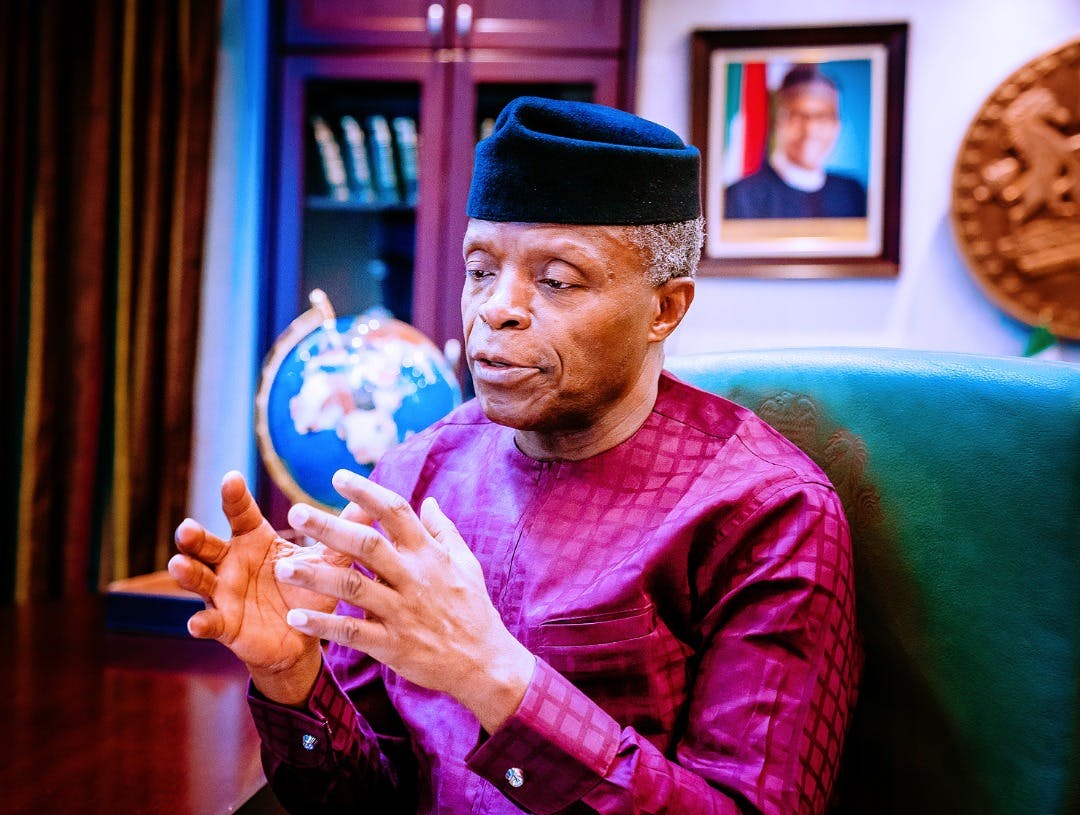Nigeria will prioritize clean and sustainable energy- Osinbajo
NEWS
|Nov 15, 2021


Vice President Yemi Osinbajo on Thursday said Nigeria has made it a priority to provide clean, sustainable and reliable energy access to her citizens, in line with President Muhammadu Buhari’s announcement at COP26 in Glasgow for Nigeria’s commitment to net-zero emissions by 2060.
“Providing clean, sustainable and reliable energy access is tied to almost all Nigeria’s development goals. We have proven that transforming our energy system is a national priority through our Economic Sustainability Plan, and most recently with our President, President Muhammadu Buhari’s announcement at COP26 in Glasgow for Nigeria’s commitment to net-zero emissions by 2060,” he said.
The Nigeria Integrated Energy Planning Tool was developed by the Federal Government in collaboration with Sustainable Energy for All (SEforALL), a United Nations initiative, with support from The Rockefeller Foundation.
“Providing clean, sustainable and reliable energy access is tied to almost all Nigeria’s development goals. We have proven that transforming our energy system is a national priority through our Economic Sustainability Plan, and most recently with our President, President Muhammadu Buhari’s announcement at COP26 in Glasgow for Nigeria’s commitment to net-zero emissions by 2060,” he said.
The Nigeria Integrated Energy Planning Tool was developed by the Federal Government in collaboration with Sustainable Energy for All (SEforALL), a United Nations initiative, with support from The Rockefeller Foundation.
“The transition plan focuses on full electrification of the economy by 2060, including over 250 gigawatts of installed capacity, and a massive build-out of renewable energy capacity. This requires a phased approach with credible milestones and targets and includes a solar-driven capacity increase on an unprecedented scale, which amounts to about 5 gigawatts per year through 2060.”
According to him, the transition to clean cooking will also require a phased approach.
“First, a transition to LPG-based cooking, and over time, a longer-term transition to electricity-based cooking as networks improve.”
On the cost implications of reaching net-zero emissions by 2060, Prof Osinbajo mentioned that “our net-zero 2060 pathway also requires around USD 10 billion per year of funding over the next 40 years across the country’s economy, and most of this will be for the power sector.
“The data and evidence that the Energy Transition Plan was based on were instrumental in helping us understand the true scale of effort and resources that would be required.
“Just yesterday the Energy Transition Plan was considered by the Federal Executive Council, while approving it, the President directed that the lead Ministry, the Ministry of Environment engages with all MDAs and stakeholders to develop a robust implementation plan.”
Prof Osinbajo, while expatiating on the usefulness of the tool, said the “robust and dynamic data on the Nigeria Integrated Energy Planning Tool that we are proud to be launching today is an important component of that effort as it begins to translate the Energy Transition Plan roadmap into concrete electrification, clean cooking, and productive use projects.
“It will help determine clear strategies for prioritization of regions and technology interventions towards making informed decisions that support our energy access by 2030 goals in a comprehensive manner which further supports and complements our net-zero by 2060 ambitions.
“This new geospatial tool not only has updated data on our populations’ electricity needs, including on productive use but also incorporates clean cooking data to guide implementation of clean cooking solutions.”
On Nigeria achieving universal access to energy by 2030, the VP stated that “the analysis has shown us we would need an estimated 19.3 million new electricity connections across the country.
“In addition, we would need over 11 million grid densification connections owing to population growth in settlements that currently have access to electricity.”
Prof Osinbajo added that “the tool also helps us decide the least-cost approach to achieving these targets, which consists of 5.4 million grid connections, 8.9 million mini-grid connections, and 5 million solar-home system connections at a cost of USD 25.8 billion.”
Noting that the Integrated Energy Planning tool would be essential in government achieving its stated goals, the Vice President gave a commitment in ensuring “that our various levels and arms of government promote it and use it as broadly as possible.”
In terms of financing, Prof Osinbajo called on the “international community to support Nigeria’s transition efforts through realistic and much-needed climate finance commitments.
“While we put forward a comprehensive emissions reduction pathway with near-term and long-term actions and milestones, our ask is for a fair exchange in terms of commitments from development partners.”
The energy planning tool is powered by extensive geospatial modelling and layers of data, and for the first time covers electrification, clean cooking, and productive use. The interactive platform will provide actionable intelligence for the Government and private sector stakeholders to deliver the least-cost access to electricity and clean cooking in Nigeria.
Also in attendance at the global launch were the Deputy Secretary-General of the United Nations, Ms Amina J. Mohammed; Mrs Damilola Ogunbiyi, CEO and Special Representative of the UN Secretary-General for Sustainable Energy for All; Minister for Power, Abubakar Aliyu; Minister of State for Power, Godwin Agba, Minister of State for Environment, Sharon Ikeazor; Mr Ahmad Salihijo, the Managing Director of the Rural Electrification Agency; Riccardo Puliti, Vice President for Infrastructure at World Bank; President of Rockefeller Foundation, Dr Rajiv Shah; and other development partners.
– Gatekeepers News